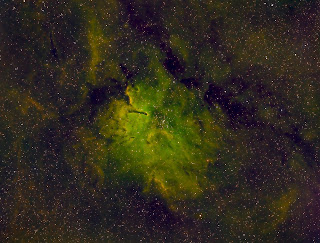If you are wondering why I imaged the second most photographed galaxy (M33), because it's there. What I mean is that I have a poor field of view and at that particular time there are not a lot of choices from my location. I imaged this for couple of hrs. each night while waiting for another target - this is visible for longer periods in my FOV but the other targets are not. The good thing is this is only the third time I have ever imaged it an the first time with the AT115 EDT (115mm refractor) so I was able to get closer in than my previous times with the ED80 (80mm refractor).
M33 or Triangulum is a spiral galaxy and is the third largest member of the Local Group of galaxies, after Andromeda and the Milky Way. It is located 3 million light-years from Earth in the Triangulum Constellation and can be seen with the naked eye in dark locations. Triangulum is moving towards Andromeda and studies from 2005 and 2011 suggest that it may have interacted with Andromeda in the past. Several regions contain star-forming HII nebula some of which are visible in my image. One of the largest Ha regions in the Local Group of galaxies, NGC 604, is found in Triangulum. It is estimated to be 1500 light-years across making it 40 times larger than the visible portion of Orion. On my image it is the large red area to the left of the core in one of the main arms. Hubble has a detailed image of NGC 604 (https://apod.nasa.gov/apod/ap121211.html) and surprisingly some the detail is visible on my image closeup.
I like the blue tone this time around more than the magenta tone of my previous images. Processing was tough mainly due to my luminosity data - captured a lot but I seem to have developed on odd problem recently. There are two artifacts/regions that the flats do not seem to fix. I reprocessed the luminosity without the flats and there was no problem. When I have the camera on live view with the luminosity filter, I notice the darker regions. I am thinking a couple of spots on the luminosity filter but wonder why without the flats the image was fine? Oh well, so I spent a lot of time tweaking this layer.
I blended the Ha into the red channel at 50 % with PixelMath although I did try other percentages I did not want to make the Ha region look too harsh - wanted a softer feel. I blended only the galaxy portion of the Luminosity layer in at 50 % as well - enough to add to the outer reaches but so much that it overexposed the core region.
Dates: 11-2-20, 11-3-20, 11-4-20, 11-6-20, 11-8-20, 11-9-20, 11-10-20, 11-13-20, 11-14-20
M33 - Triangulum Galaxy
Dates: 11-2-20, 11-3-20, 11-4-20, 11-6-20, 11-8-20, 11-9-20, 11-10-20, 11-13-20, 11-14-20
Camera: ZWO ASI1600MM-Pro Telescope: Astro-Tech AT115EDT 115mm Refractor Telescope
Barlow: None
Focal Length: 805mm
f/7
Focal Reducer: AstroTech Field Flatterner/Focal Reducer
Mount: Orion Sirius
Filter Wheel: ZWO EFW 8 x 1.25"
Filter: ZWO Ha, L, R, G, B
Focuser: ZWO EAF
Autoguiding: ASI120 Mini attached to an Agena 50mm Guide Scope/ZWO 60mm Guidescope
Exposure: Ha 66 x 240, L 141 x 90, R 72 x 90, G 80 x 90, B 80 x 90
Gain: 139
Offset 21
Temp: 5 C
Processing: APT, NINA, PixInsight, DSS, Photoshop, Topaz DeNoiseAI.
https://kurtzeppetello.smugmug.com/
http://astroquest1.blogspot.com/
https://www.astrobin.com/users/kurtzepp/collections/ http://youtube.com/c/AstroQuest1































